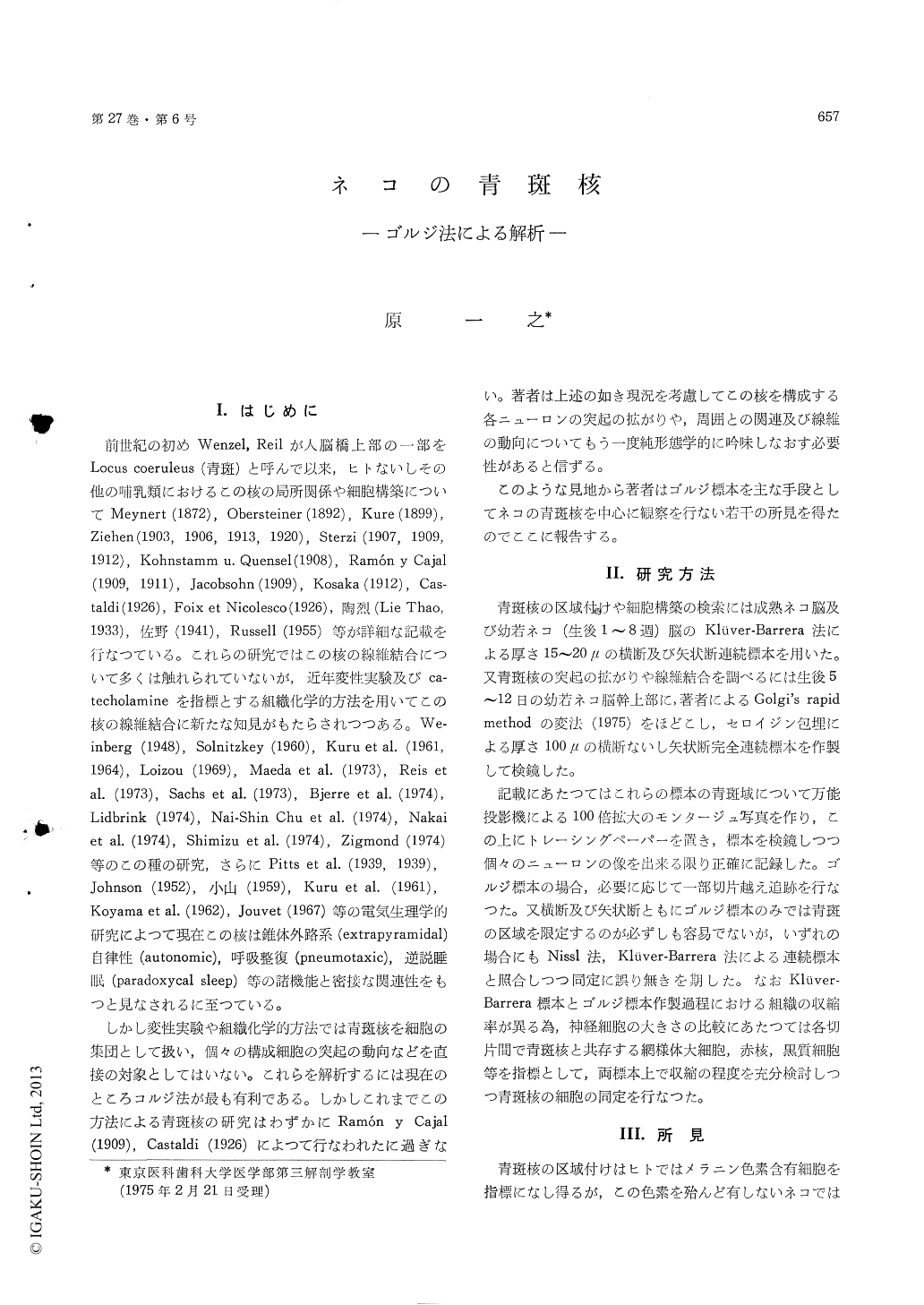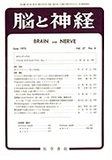Japanese
English
- 有料閲覧
- Abstract 文献概要
- 1ページ目 Look Inside
I.はじめに
前世紀の初めWenzel,Reilが人脳橋上部の一部をLocus coeruleus (青斑)と呼んで以来,ヒトないしその他の哺乳類におけるこの核の局所関係や細胞構築についてMeynert (1872),Obersteiner (1892),Kure (1899),Ziehen (1903,1906,1913,1920),Sterzi (1907,1909,1912),Kohnstamm u. Quensel (1908),Ramón y Cajal(1909,1911),Jacobsohn (1909),Kosaka (1912),Cas—taldi (1926),Foix et Nicolesco (1926),陶烈(Lie Thao,1933),佐野(1941),Russell (1955)等が詳細な記載を行なつている。これらの研究ではこの核の線維結合について多くは触れられていないが,近年変性実験及びca—techolamineを指標とする組織化学的方法を用いてこの核の線維結合に新たな知見がもたらされつつある。We—inberg (1948),Solnitzkey (1960),Kuru et al.(1961,1964),Loizou (1969),Maeda et al.(1973),Reis etal.(1973),Sachs et al.(1973),Bjerre et al.(1974),Lidbrink (1974),Nai-Shin Chu et al.(1974),Nakaiet al.(1974),Shimizu et al.(1974),Zigmond (1974)等のこの種の研究,さらにPitts et al.(1939,1939),Johnson (1952),小山(1959),Kuru et al (1961),Koyama et al.(1962),Jouvet (1967)等の電気生理学的研究によつて現在この核は錐体外路系(extrapyramidal)自律性(autonomic),呼吸整復(pneumotaxic),逆説睡眠(paradoxycal sleep)等の諸機能と密接な関連性をもつと見なされるに至つている。
しかし変性実験や組織化学的方法では青斑核を細胞の集団として扱い,個々の構成細胞の突起の動向などを直接の対象としてはいない。これらを解析するには現在のところコルジ法が最も有利である。しかしこれまでこの方法による青斑核の研究はわずかにRamón y Cajal(1909),Castaldi (1926)によつて行なわれたに過ぎない。著者は上述の如き現況を考慮してこの核を構成する各ニューロンの突起の拡がりや,周囲との関連及び線維の動向についてもう一度純形態学的に吟味しなおす必要性があると信ずる。
The cytoarchitecture as well as the axonal and dendritic trajectories of neurons of the locus ceruleus in the cat were studied by means of serial sections stained by the Kluver-Barrera method (from 1 week of age to adult) and Golgi's method (from 5 days to 12 days of age). The article contains the results thus obtained.
(I) The nucleus loci cerulei in the cat extendsfrom the level of the caudal end of the colliculus inferior to the rostral end of the trigeminal motor nucleus. Occupying the dorsolateral part of the pontine tegmentum, it is divided into two sections of which the dimensions are approximately equal : the dorsal section that spreads over the lateral part of the central gray matter (cgm-section) and the ventral section that occupies the dorsolateral part of the pontine reticular formation (rf-section). The actual dimensions of this nucleus are ca. 2. 4 mm in rostro-caudal length, ca. 1. 3 mm in medio-lateral diameter and 1.3 mm in dorso-ventral diameter in the adult cat. This nucleus consists of three types of neuron : large (40.0±3.9)×(17.1±3.8) μm, medium (29.6±1.9)×(17.3±3.9) ,μm and small (21.1±1.6)×(14.6±3.6)μm. Numerically, the cgm-section principally consists of small elements, while the rf-section consists of large and medium cells. In addition to these elements which are proper to this nucleus, it is possible to identify in the territory of the locus ceruleus several cell types of different origin : large, medium and small cells of the reticular formation, cells of the nucleus tractus mesencephalici nervi trigemini and the cells of the central gray matter.
(II) The Golgi-stained sections reveal that three cell types of the nucleus show a similar dendritic pattern. The soma issues bipolar ventral dendrites and dorsal dendrites which bifurcate one or two times and spread out in a fan-like manner. The dendrites of the abovementioned two sections not only intermingle with one another, but they also transverse the boundary of the nucleus, invading the neighbouring structures, reticular formation, central gray matter and nucleus tr. mesenceph. n. trigemini. On the other hand, the dendrites of the neurons of these neighbouring structures and of those found between the locus ceruleus and the superior cerebellar peduncle and in the interior of the lateral lemniscus enter the locus ceruleus, traversing the limit of the nucleus. In regard to these dendritic patterns, the locus ceruleus belongs to the "Noyau ouvert" of Mannen. The dendrites of several elements of the reticular formation con-tained within the locus ceruleus radiate in all di-rections. In this respect, they differ from those of the locus ceruleus which show bipolar dendritic fields in the majority of cases.
(III) The axons of the large cells of the nucleus loci cerulei which are very coarse take a three-dimensional dorsolaterocaudal course and enter the superior cerebellar peduncle of the ipsilateral side They seem to run finally into the cerebellum. On the way, they have no contact with the nucleus tr. mesenceph. n. trigemini. The axons issued from the medium neurons are relatively fine and followa more or less intricate intranuclear course. They can be classified into three groups according to extranuclear course. Those of the first group, after gaining the caudal end of the nucleus, take a descending course in the dorsolateral part of the pontine tegmentum of the ipsilateral side without forming any conspicuous bundle, while those of the second group begin to ascend at the rostral end of the nucleus in the comparable part of the teg-mentum. The axons of the third group run ventral-ward and intermingle with the reticular fibers, andthen they take an ascending course in the ventral part of the pontine tegmentum of the ipsilateral side. The axons of the small cells, which are very fine, emerge in a ventral direction and traverse the dorsal part of the rf-section. After attaining the medial rand of the locus ceruleus, they take an ascending course. Unfortunately it was im-possible to follow their trajectories further in this study.

Copyright © 1975, Igaku-Shoin Ltd. All rights reserved.


